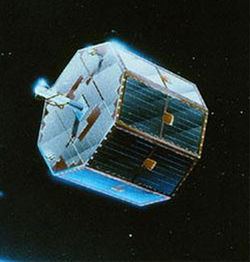COSPAR ID 1993-009B Website SCD-1 Launch date 9 February 1993 | Operator INPE SATCAT no. 22490 Mission duration 1 year (planned) Rocket Pegasus | |
 | ||
Manufacturer National Institute for Space Research Similar CBERS‑1, CBERS‑2, China–Brazil Earth Res, CBERS‑4, VLM | ||
The first Data-Collecting Satellite (Portuguese Satélite de Coleta de Dados) (aka SCD-1) was launched on February 9, 1993. It is the first satellite developed entirely in Brazil and it remains in operation in orbit to this date. SCD-1 was designed, developed, built, and tested by Brazilian scientists, engineers, and technicians working at INPE (National Institute of Space Research) and in Brazilian industries. It was made to be launched with a Brazilian rocket in 1989. Once it was officially recognized that the rocket could not be completed until many years later, SCD-1, after undergoing minor adaptations, was finally launched with a Pegasus rocket made by Orbital Sciences, a private United States corporation. The rocket was launched from a B-52 airplane while flying over the Atlantic Ocean.
Contents
SCD-1
SCD-1 is an experimental communication satellite with an environmental mission. It receives data collected on the ground or at sea by hundreds of automatic data-collecting platforms (DCPs) and retransmits all the information in a combined real-time signal back to tracking stations on Earth. Applications include hydrology, meteorology, and monitoring of the environment in general. The data are used by agencies such as the Weather Forecasting and Climate Studies Center (Centro de Previsão do Tempo e Estudos Climáticos—CPTEC), hydroelectric power managers, and both private and governmental institutions with many different interests. An example is meteorological and environmental data collected in the Amazon region, including the levels of carbon monoxide and carbon dioxide in the atmosphere. These data are transmitted to INPE and are used for monitoring forest fires.
SCD-1 weighs approximately 110 kg and goes around the Earth every 100 minutes on a nearly circular orbit at about 760 km altitude. The inclination of the orbit with respect to the plane of the equator is 25 degrees, providing excellent coverage of equatorial, tropical, and subtropical regions (up to about 35 degrees of latitude) around the world. The spin-stabilized spacecraft has the shape of an octagonal prism, with a diameter of 1 meter and a height near 70 cm without the antennas that are mounted on both base surfaces. It was originally designed for a life of one year with 80% probability, but it has survived 14 years in operation without any crippling functional failure. However, since its chemical (nickel-cadmium) batteries are now completely run down, the satellite can no longer be used while it is in the Earth's shadow.
After the buzz of the New Horizons spacecraft flyby of NASA in July 2015, revealing feature and characteristics on Pluto, the International Astronomical Union (IAU) will scan an area on the surface of Pluto, which possibly will be named after the Sátelite Coleta de Dados (SCD-1), as “ Coleta de Dados”, located in the large Tombaugh Regio, inside the area Sputnik Planitia.
More than thirty companies were involved in the production of the SCD-1, with INPE itself providing much of the electronics.
SCD-2
The SCD-2 has the function to collect the environmental data to be later picked up by tracer stations and be distributed to organizations and to various users. The SCD-2 was launched on October 23, 1998, by a rocket type Pegasus, he was transported under the wing of a Lockheed L-1011 Tristar, that launched him to 13 km altitude. It is the second satellite fruit MECB - Complete Brazilian Space Mission - program developed by INPE which already incorporated solar panels fitted with technology developed in Rio Grande do Sul, Brazil, in partnership with the project team of the satellite's power subsystem by INPE.
On her 10th birthday, on 23 October 2008, the SCD-2 completed 52,807 orbits around the Earth. Within a decade, covered a distance of 2,365,088,861 kilometers, which corresponds to 3,112 times round trips to the moon and back (distance between Earth and the Moon: approximately 236,000 miles).
CBERS
INPE has plans to develop other small to medium-size satellites in Brazil with domestic industry. An important on-going program (also started in the 1980s), CBERS, is a partnership of China and Brazil. It has produced two polar-orbit sun-synchronous remote sensing satellites. Both were successfully launched by the Chinese, and CBERS-2 remains in operation.
